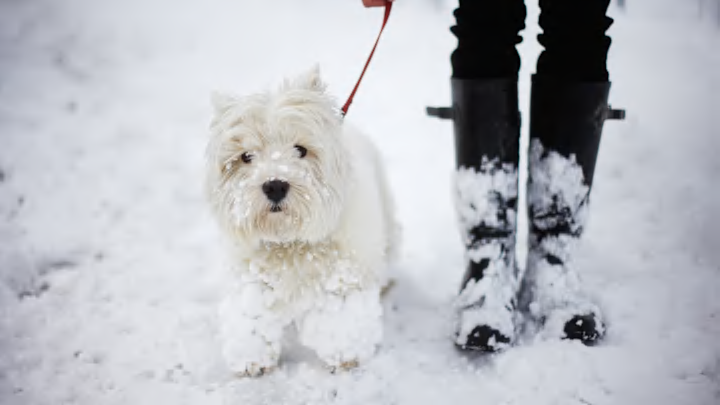For most people, freezing temperatures mean the added burden of scraping ice off cars, making sure plumbing pipes don’t freeze, and keeping snow cleared from driveways. Lingering in the cold weather is kept to a minimum.
For dog owners, the objective is to give their pets a chance to exercise while they’re bundled in all manner of dog winter jackets and boots. If you’re one of the many who are curious about what additional precautions you need to take to walk your dog in unforgiving conditions, check out these methods for winterizing your furry family member.
- Buy your dog a winter jacket
- Use boots or gel to protect their paws from snow, ice, and rock salt
- Choose the right leash for winter walks
- Do a post-walk check
- Watch for signs your dog is uncomfortable
Buy your dog a winter jacket

Pet accessories are usually designed to be adorable without a lot of practical functionality. The exception is a dog winter jacket or coat. Short-haired pups and smaller breeds are particularly prone to being uncomfortable in frigid conditions and need help conserving their body heat. Select a waterproof winter coat that covers the chest and abdomen. Brighter colors are better for visibility, especially if your dog has light-colored fur. (If they go off-leash, they’ll be easier for you and others to spot.)
Use boots or gel to protect their paws from snow, ice, and rock salt

A dog’s paws can stand up to some pretty tough terrain, but prolonged exposure to snowy, icy surfaces will eventually prove uncomfortable. You can apply a wax or gel (petroleum jelly will work) to help protect their skin, but make sure you wash it off when you’re done. Some pet owners opt for dog winter boots, which can help keep paws dry and weather-resistant. If your dog resists the idea of wearing booties, you can put them on and then divert their attention to a meal, treat, or going out the door right away.
Choose the right leash for winter walks

If your dog is the type who winds up walking you, make sure you have a leash that allows you to retain more control over unpredictable winter surfaces. A harness takes the strain off the dog’s neck and makes it easier for you to direct its path. Avoid retractable leashes, as it’s harder to control the slack. If you’re prone to walking over really precarious areas, a jogger’s leash that fits around your waist will keep your dog tethered in the event that you fall and lose your grip.
Do a post-walk check

If you opt to let your dog go barefoot, make sure you wash off any salt or antifreeze when you get home. Wipe down their belly, too, since it can also come in contact with de-icing products. These compounds are irritating to their paws and toxic if ingested. Make sure you keep them away from any chemical puddles they encounter outside, too.
Watch for signs your dog is uncomfortable

Dogs tend to shake, turn toward your house, or leave their paws raised when the cold is getting to be too much. Certain breeds may also be more tolerant to colder temperatures than others, particularly if it’s below 30°F. (You can view this chart for information on weather conditions and the potential risk to animals.) If you observe any of these signs, it’s best to finish the walk and let your pet warm up back home.
Read More About Dogs:
A version of this story originally ran in 2019; it has been updated for 2025.
